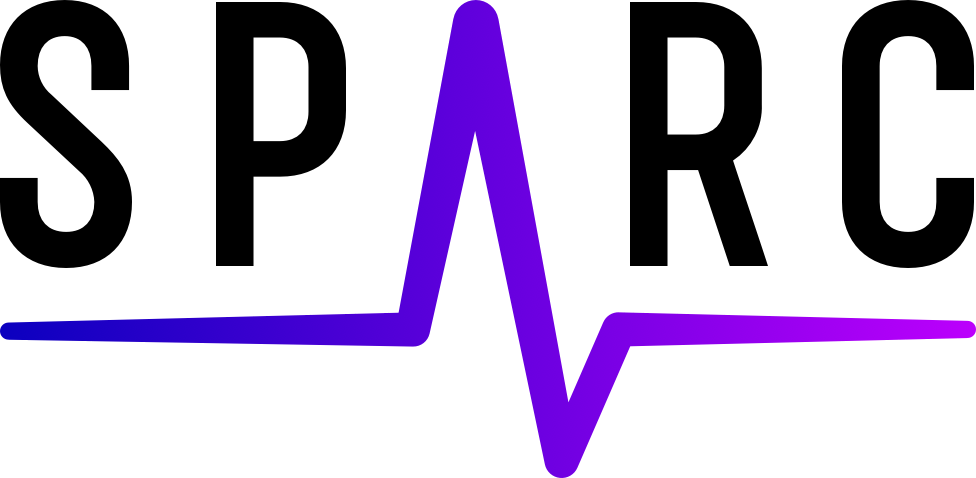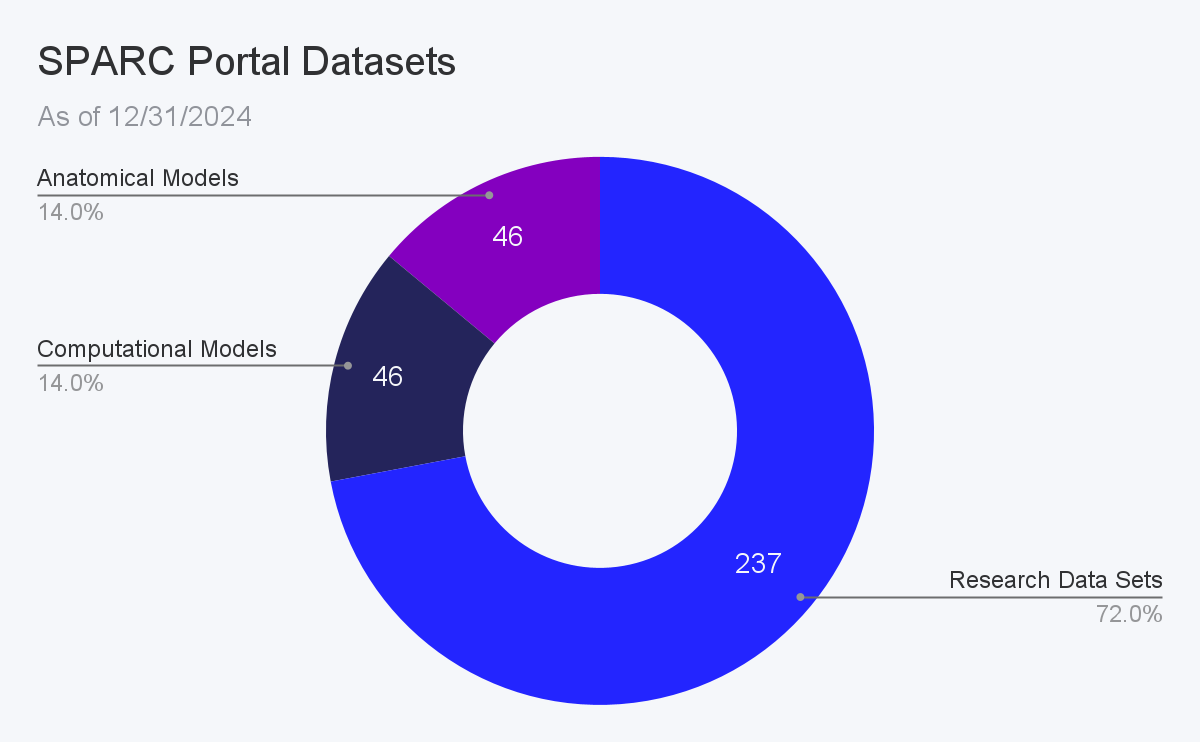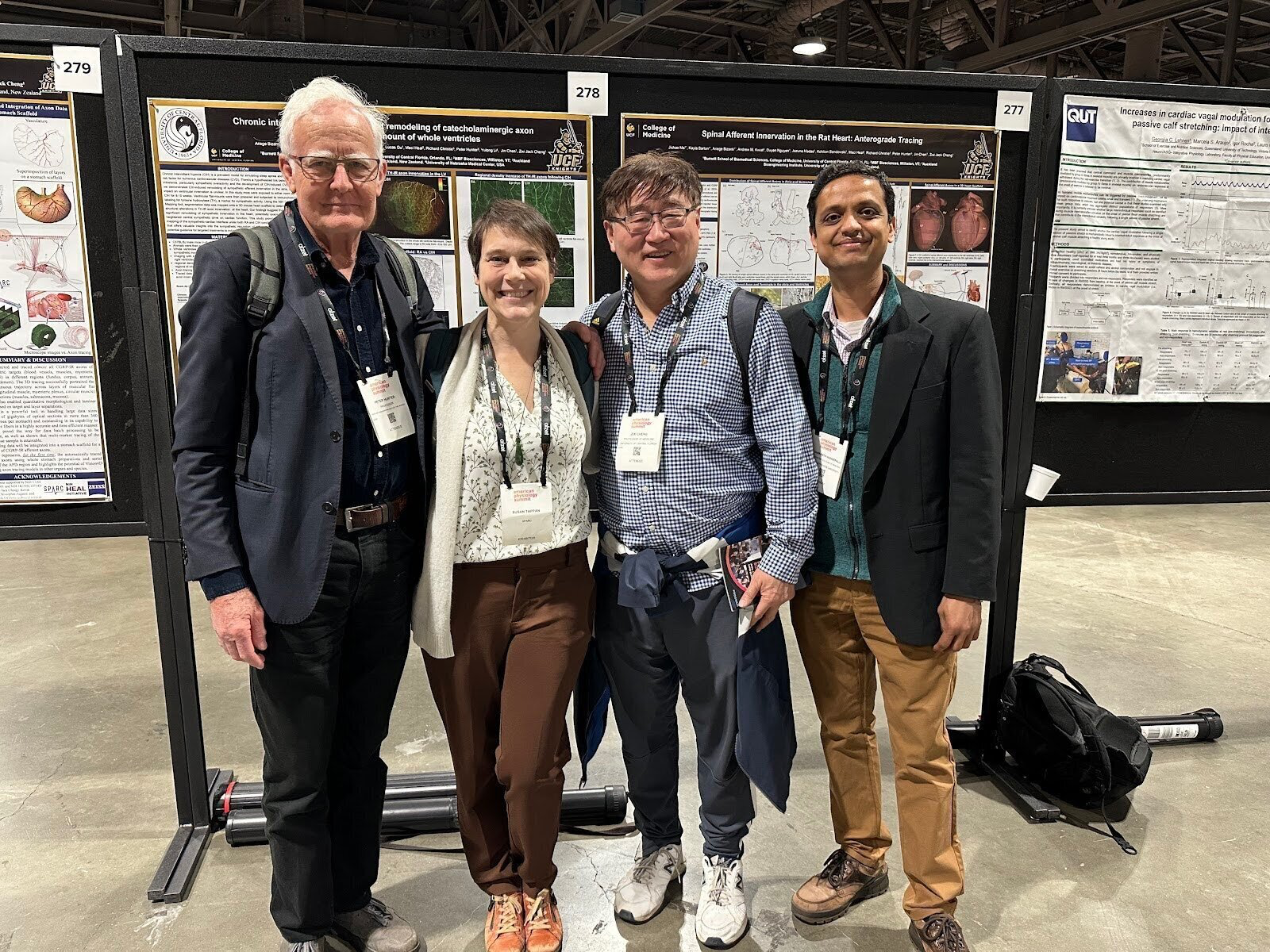SPARC Plug Winter 2025
Originally published 2025/02/19

Click the above link, then select desired language from above.
A Message from our Leadership
We at the SPARC Data and Resource Center want to extend our heartfelt thanks to you, our incredible community, for your steadfast support. Your commitment—shown through your signatures on our Letter of Support for our recent funding proposal—has been nothing short of inspiring. Over 150 researchers in our community added their signatures, and we are deeply grateful for each and every one of you.
As we navigate this next phase for SPARC, we are more determined than ever to ensure the SPARC Portal remains a thriving, open, and accessible resource for the biomedical research community. Our vision is to expand the SPARC Portal as a sustainable and interoperable cornerstone of the biomedical data ecosystem. The engagement and collaboration of users like you are what will allow us to continue building this vibrant, shared space for data integration and innovation.
Thank you once again for being a vital part of this journey. Your support means the world to us.
SPARC News
SPARC Portal continues to grow
The SPARC Portal continues to grow, hosting a total of 329 datasets, including 237 research datasets, 46 computational models, and 46 anatomical models at the end of December 2024.

A Diversity of Data
At the SPARC Data and Resource Center, we are proud to support research teams from four key consortia while also welcoming contributions from the broader peripheral neuroscience and systems physiology community. Our goal is to provide a comprehensive and interconnected resource that spans from the organ level to the genetic and molecular scale.
Explore the SPARC Portal to discover the diverse range of data we publish, which comes from various funding sources, including NIH, DoD, EU, and non-governmental organizations. Whether you're studying the function of entire organs, the development of tissues, or the intricate details of individual genetic variants, our Portal enables you to navigate across multiple dimensions, model systems, and research modalities.
We begin with organ-level studies, such as Dr. Robert Heuckeroth's NIDCD-funded research that maps the enteric nervous system in the distal colon of both normal human pediatric cases and those affected by Hirschsprung disease. This study offers valuable insights into organ function and pathology. Explore Dr. Heuckeroth's dataset.
Next, at the tissue level, we have Dr. Tiffany Glass's NIDCD INCLUDE-funded project, which provides high-resolution images of entire tissue sections of the intrinsic tongue of mice. These sections are stained to highlight markers of myofiber biology, offering a closer look at tissue development and muscle function. Explore Dr. Glass's dataset.
Moving into the realm of tumor biology, Dr. Grant McCallum’s DoD-funded research delves into the neural recordings of spontaneously metastasizing melanomas and melanomas with low metastatic potential, shedding light on the physiological impacts of cancer and its metastatic behavior. Explore Dr. Grant McCallum’s dataset.
Finally, at the molecular scale, the NIH PRECISION Human Pain Network, one of the four consortia supported by SPARC, provides several datasets focused on the human dorsal root ganglion (hDRG). These datasets are essential for understanding the genetic and proteomic factors that underlie pain mechanisms and to inform bioelectronic medicine approaches. Explore the NIH PRECISION Human Pain Network datasets.
The SPARC Portal continues to grow, emphasizing our commitment to providing high-quality, open-access data that empowers researchers to drive innovation in bioelectronic medicine and beyond. We invite you to explore the richness of these datasets and contribute to the expanding world of knowledge that bridges the gap from organ function to genetic detail.
Join us in making the SPARC Portal an even richer resource for the scientific community. Together, we can advance the frontiers of research and foster a collaborative environment that drives discovery.
SPARC Webinar Research Series - Bridging the body and brain
Mark your calendars! We're excited to introduce the SPARC Webinar Research Series, a set of webinars showcasing groundbreaking contributions from research teams who have shared their data and models on the SPARC Portal. These sessions provide unique insights into cutting-edge science, offering a deep dive into topics at the forefront of biomedical research, straight from the scientists themselves. Stay tuned for more details.
Announcing the SPARC Emerging Scientist Award Winners
This year, SPARC Phase 2 teams will converge to share outcomes and collaboration plans at the SPARC Phase 2 PI Meeting in Cleveland, Ohio on March 12-13.
During the scientific highlight session, we are thrilled to recognize the recipients of the Emerging Scientist Awards! The selection process was challenging, as we received outstanding submissions from many talented early-career scientists. After much deliberation, our judges have chosen six winners to present their cutting-edge research:
- Ian Baumgart, MS; Duke (REVA-CWRU)
- Zixin Chen, PhD Candidate; USC (HORNET CARSS)
- Xinghao Huang, Mechanical Engineering/PhD Candidate; USC (HORNET CARSS)
- Talya Jeter, MS; Case Western (REVA CWRU)
- Noa B. Nuzov, MS; Case Western (REVA CWRU)
- Maryam Zebarjadi, Electrical Engineering/PhD Candidate; University of Minnesota (VESPA REVEAL)
Each awardee will deliver a flash presentation, showcasing their contributions to advancing our understanding of peripheral nervous system function and its therapeutic potential. This award honors their dedication, insight, and impact on the SPARC community.
Congratulations to this year’s awardees!
SPARC community members map pain-sensing nerves in rat heart
In a new study published in Journal of Comparative Neurology, researchers in Dr. Cheng’s lab at the University of Central Florida (UCF) have for the first time mapped the spinal afferent innervation of the rat heart. Cardiac sensory information is transmitted through two primary pathways: vagal afferents from the nodose ganglia and spinal afferents from the dorsal root ganglia. While spinal afferents are crucial for detecting and relaying pain signals, they are less studied than their vagal counterparts (Cheng et al., 1997). Previously, this team used a novel anterograde tracing technique to label spinal afferent innervation of the rat stomach (Ma et al., 2023). Now, this advanced tracing method has been adapted to label spinal afferent projection to the heart.
Detailed imaging showed the axons forming simple to complex terminal structures in various layers, including the epicardium and myocardium but rarely the endocardium, while structurally interacting with cardiac muscles, blood vessels, and fat tissues. These findings enable researchers to compare terminal structures and their targets of spinal and vagal afferents in different layers of the atrium, which increases our understanding of the distinct innervation patterns of these sensory pathways.
This detailed map of cardiac spinal afferent innervation establishes an anatomical foundation for further functional studies of this pathway and its remodeling in heart diseases. Furthermore, the use of this anterograde tracer technique opens new possibilities to explore spinal afferent innervation in other visceral organs.
Read more about this exciting advance.
SPARC-funded device attains 510(k)
In Phase 1 of the program, SPARC funded Hans Gregersen and team at California Medical Innovations Institute to develop a sensor to measure colonic motility and anorectal function in humans, which could be used to measure outcomes in neuromodulation studies. This fecobionics device now has received 510(k) premarket certification from the FDA. Read their SPARC Story, and check out the project. Please join us in congratulating the California Medical Innovations Institute team, and plan to attend the SPARC Research Webinar series, where Dr. Gregersen will offer insights into his experience navigating the FDA certification process.
Conferences
The Sixth BEM Summit: Neurotechnologies for Individuals and Communities
March 4-5, 2025, Garden City, NY
The Sixth Bioelectronic Medicine Summit: Neurotechnologies for Individuals and Communities will be held from March 4-5, 2025 at The Garden City Hotel, NY. This in-person event will feature leaders in the field discussing the latest advancements in bioelectronic medicine, including personalized therapies and scalable solutions for broader impact. Attendees will explore how neurotechnologies are shaping the future of healthcare for individuals and communities.
The Summit is hosted by Dr. Stavros Zanos, Head of Translational Neurophysiology Lab, Institute of Bioelectronic Medicine, Feinstein Institutes for Medical Research and Dr. Hubert Lim, Earl E. Bakken Medical Device Center, University of Minnesota.
Presenting? If your poster is accepted by the BEM Summit, let us know! We would love to see it. Send to [email protected]!
Find more information on The Sixth BEM Summit here.
6th Annual Bio IT World Hackathon
April 1-2, 2025, Boston MA
The 6th Annual Bio IT World Hackathon will continue to unite life science and IT professionals to address pressing data challenges using Open Source and FAIR Data approaches. Facilitated by leaders from the NIH Common Fund Data Ecosystem (CFDE), this year’s event will emphasize projects leveraging omics data and integrating CFDE tools, improving interoperability across datasets to accelerate discoveries.
The CFDE ensures Common Fund data is accessible and reusable, providing researchers with a centralized online platform for integrating multiple resources seamlessly—enabling new insights and scalable solutions. As a partner in the CFDE, SPARC encourages our community to participate in this cross-disciplinary event.
The deadline to submit a project proposal for review is February 28.
Complete this form by February 28, 2025, to join the Bio-IT World FAIR Hackathon. The Hackathon is in-person and free to participate.
Find out more about the Bio-IT World Hackathon
American Physiology Summit
April 24-27, 2025, Baltimore, MD
SPARC is excited to attend the 2025 American Physiology Summit (APS) April 24-27, bringing together thousands of life science researchers, educators, and students to explore the latest breakthroughs in physiology. Join your vibrant, diverse community to celebrate and share the discoveries impacting the research community and the world around us.
Find Us At Booth #1414
Visit us to discover how SPARC’s data-sharing platform, modeling and simulation tools, and collaborative network can enhance your research. Our experts will be available to discuss how you can connect with the SPARC community, collaborate with peers, and demonstrate resources to further your work in peripheral nervous system research. We’re here to help you advance your research with open science and build meaningful partnerships within the scientific community.
Don’t Miss Our Workshops!
Join us for two engaging sessions covering essential topics like data curation offerings, research tools, and how leveraging SPARC’s open resources to boost your scientific discoveries:
- Friday, April 25 at 4:15 PM – Innovation Stage
- Saturday, April 26 at 12:15 PM – Discover Stage
We look forward to sharing insights on how SPARC can help accelerate your research and expand your scientific network. See you in April!
Presenting? If your abstract is accepted by APS, let us know! We would love to see it. Send to [email protected]!

Dr. Peter Hunter, Dr. Sue Tappan, Dr. Jack Cheng, Dr. Raj Vadigepalli
smiling at the camera at the 2024 APS Summit in Long Beach, CA
MN Neuromodulation Symposium: Future Directions of Neuromodulation
May 1-2, 2025, Minneapolis, MN
This two-day event will feature a comprehensive program with a special focus on the future of neuromodulation. Conference topics will include non-invasive neuromodulation, neuromodulation for immune health, and challenges in autonomic neuromodulation. Future opportunities with AI and lived experience perspectives will be presented. Mark your calendar!
Find more information on MN Neuromodulation Symposium here.
- Registration and poster submission opens February 1.
2025 Peripheral Nerve Society
May 17-20, 2025, Edinburgh, Scotland
The PNS Annual Meeting is the world's largest gathering on peripheral neuropathy, offering cutting-edge research, expert discussions, and networking for clinicians and scientists. Find out more about the Annual Meeting, as well as information about presenting, in News and Events on the SPARC portal.
Find more information on PNS Annual Meeting here.
New Webinars Available
Open Science Drives Discovery
Open science is changing the future of neuroscience! Learn how initiatives like SPARC are accelerating research and driving new treatments in this recent webinar featuring Dr. Sue Tappan and Dr. Ben Dichter.
Visit SPARC's Webinar YouTube channel for all our webinars.
New Tutorials Available
The DRC SIM-Core has published a new tutorial on the Portal
Running a MetaModeling Pipeline On o²S²PARC
This tutorial demonstrates how o²S²PARC's meta-modeling framework can be utilized to analyze a realistic clinical model through multiple evaluations using the Parallel Runner Service. This tutorial covers the essential concepts for meta-modeling on o²S²PARC, provides hands-on experience to users, and features an advanced section with all details needed to set up your own meta-modeling pipelines.
The DRC Map-Core has published two new tutorials on the Portal
Discovering and Reusing Connectivity Knowledge in Flatmaps
This tutorial provides a step-by-step guide to help you find, explore, and reuse connectivity knowledge in flatmaps. It includes instructions on navigating maps, searching for connections, interacting with connectivity data, and saving connectivity information effectively.
SPARC Portal Map Annotation Tool
The tutorial gives a quick start guide to achieving specific tasks using the map annotation tool to curate connectivity knowledge.
How you can help
Help Shape the SPARC Portal
We want you to influence the continuous improvement of the SPARC Portal. Your participation in our UX research and design activities will make the Portal easier to use. We encourage everyone to get involved.
Join our UX Panel at [email protected]
SPARC DRC Open Office Hours
Join one of our weekly office hours to ask questions and learn more from the SPARC Data Resource Center Team. Find out more about our office hours on the SPARC Help Center.
Share with SPARC
Whether you are an individual researcher, manage a program or a project funder interested in the peripheral nervous system, consider sharing your data on SPARC. Find out more about sharing on the SPARC Portal.
Updated 3 months ago
**Not signed up? ** Don't miss out on our next issue of SPARC Plug!
